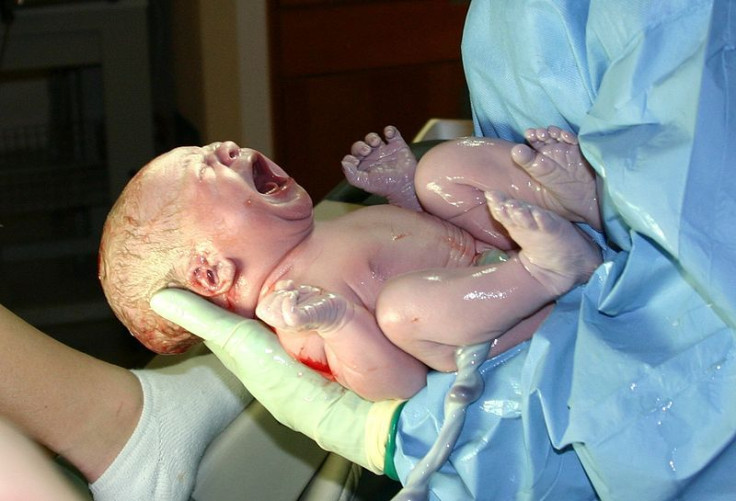Cutting Newborn's Umbilical Cord 1-3 Minutes After Birth Reduces Baby's Risk Of Iron Deficiency

Despite the common practice of cutting a newborn's umbilical cord within moments after birth, scientists now say the optimal time is somewhere between one and three minutes, in order to ensure the baby does not develop an iron deficiency.
The process of cord clamping effectively detaches a baby from the mother's supply of blood and oxygen, which derives from the placenta. As the baby is delivered, residual blood pumps through the baby's bloodstream. Cutting the umbilical cord immediately can deprive the newborn's organs of the blood necessary for functioning. A one to three minute waiting period allows this residual blood sufficient time to circulate, allowing the baby's organs to function better once the cord is clamped.
Research from the National Institute for Health and Care Excellence shows that "placental transfusion," the process of oxygen and blood transferring from the mother's placenta to the baby via the umbilical cord, is an essential process that takes place even after delivery.
"In light of growing evidence delayed cord clamping increases early hemoglobin concentrations and iron stores in infants," said Dr. Philippa Middleton, researcher and perinatal epidemiologist at the University of Adelaide, "a more liberal approach to delaying clamping of the umbilical cord in healthy babies appears to be warranted."
Published in The Cochrane Library, the study included 15 randomized trials involving a total of 3911 women and infant pairs. It saw a number of positive results, such as "higher birth weight, early hemoglobin concentration, and increased iron reserves up to six months after birth."
The one downside to delayed cord cutting is a slight increase in the baby's risk for jaundice; however, Middleton said the benefits of maintaining iron levels could outweigh that risk.
"The benefits of delayed cord clamping need to be weighed against the small additional risk of jaundice in newborns," she said, adding phototherapy as a potential concern for such a case.
Another study, published late last year, mirrored Middleton's findings.
Also consisting of 15 randomized controlled trials "with 738 babies born prematurely between 24 and 36 weeks' gestation by caesarean section or vaginal birth," researchers compared babies whose cord was clamped within a few seconds after delivery and others after a delay of 30 seconds. No baby considered had an umbilical cord clamped after 180 seconds.
It also found milking the cord — manually directing the cord's contents toward the baby — helped the baby's bodily functions after clamping.
"Providing babies with additional blood through delayed cord clamping or milking the cord before clamping appeared to help the babies to adjust to their new surroundings," the researchers concluded. "Fewer babies needed transfusions for anemia, the risk of bleeding in the brain (intraventricular hemorrhage) and the risk of necrotizing enterocolitis (a severe infection in the bowel) were reduced."
Middleton also added that delayed cord clamping could have an environmental component as well.
"Later cord clamping to increase iron stores might be particularly beneficial," she said, particularly "in settings where severe anemia is common."
Sources: McDonald S, Middleton P, Dowswell T, Morris P. Effect of timing of umbilical cord clamping of term infants on maternal and neonatal outcomes. The Cochrane Library. 2013.
Rabe H, Diaz‐Rossello JL, Duley L, Dowswell T. Effect of timing of umbilical cord clamping and other strategies to influence placental transfusion at preterm birth on maternal and infant outcomes. Cochrane Database of Systematic Reviews. 2012.
Published by Medicaldaily.com



























